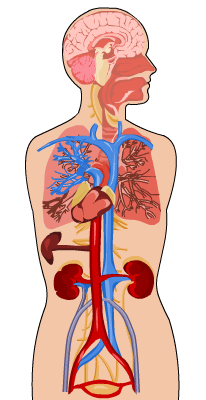Receptors
The receptors in the circulation that recognize changes in cardiovascular or fluid volume state are known as baroreceptors, but in fact respond to stretch. There are high pressure baroreceptors and low pressure baroreceptors.
Both high and low pressure baroreceptors are activated by an increase in pressure from the normal state. The response to hypovolaemia and hypotension is therefore brought about by the fall in activity of these systems and abolition of the responses that they generate.

High pressure baroreceptors
These are located in the carotid sinus and aortic arch and respond to a change in arterial pressure. When distended they produce inhibition of sympathetic stimulation to the heart and circulation and an increase in parasympathetic (vagus) stimulation to the heart, resulting in:
- Bradycardia
- Peripheral vasodilatation
The sympathetic inhibition also reduces the release of adrenaline and noradrenaline from the adrenal medulla into the circulation.
Low pressure baroreceptors
These are located in the right atrium and predominantly identify a change in volume state via small changes in atrial pressure. When distended they release atrial natriuretic peptide (ANP) which produces an increase in sodium and water excretion by the kidney, brought about by:
- An increase in glomerular filtration rate (GFR) created by afferent arteriolar dilatation and efferent arteriolar constriction
- A reduction in tubular reabsorption of sodium
ANP also inhibits the release of renin from the kidney and aldosterone from the adrenal cortex.